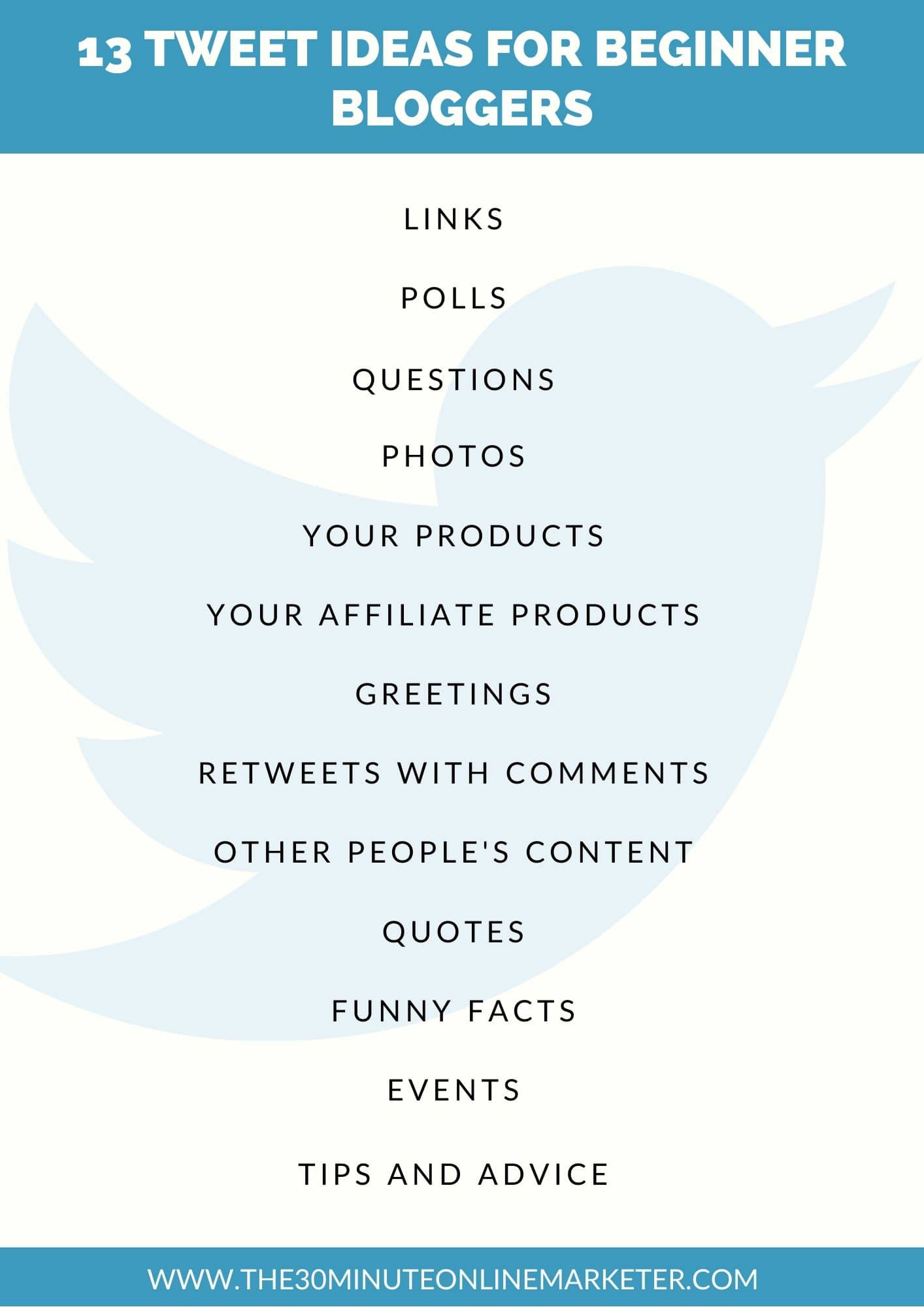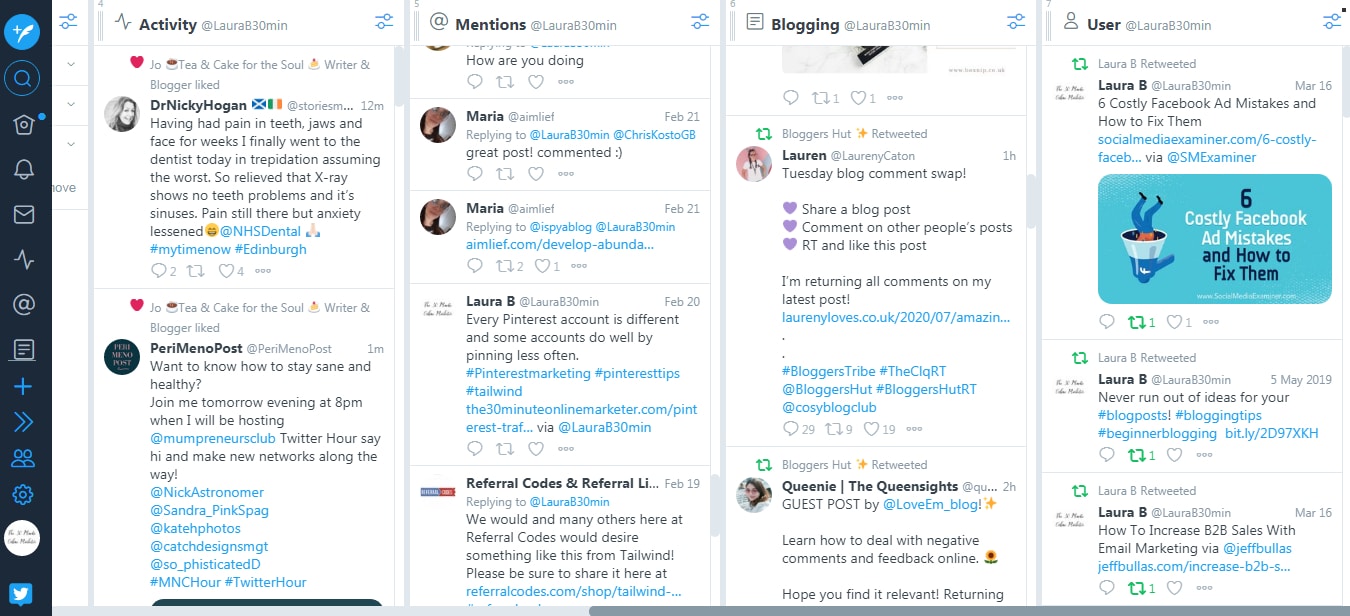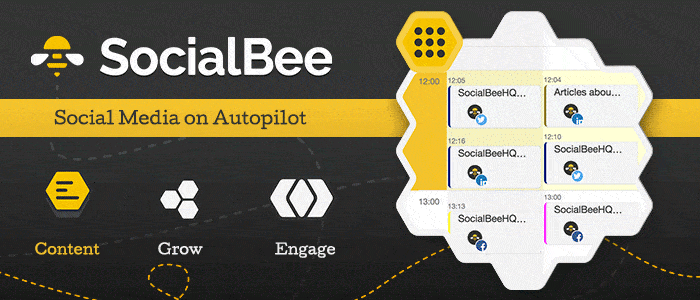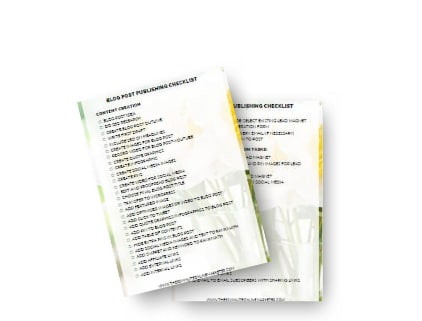Growing your profile on Twitter can be hard. The lifespan of a tweet is so short that it makes you feel like you have to be on Twitter all day in order to achieve anything. But it's a great place to make connections with other bloggers and start promoting your blog if you know what you're doing.
So if you're starting out and want to grow your blog traffic through Twitter and network with other bloggers, here's a list of some of my best Twitter Tips for Beginner Bloggers that will help you send more traffic to your blog.
More...
[Disclaimer: Some links in this post contain affiliate links. This means I get a commission if you purchase the product through my link at no extra cost to you. As an Amazon Affiliate I earn from qualifying purchases.]
IS TWITTER GOOD FOR BLOGGING?
Twitter is great for beginner bloggers that want to make connections and get to know other fellow bloggers.
It's a place where you can bring in your personality and you can chat to people and find out what's going on in your niche too.
The blogging community is very active on Twitter and they're happy to support and collaborate with other bloggers by sharing and retweeting.
It's also easier to grow your followers than on other social media.
And one of the good things about Twitter is that you can automate some of it.
HOW TO SHARE YOUR BLOG POSTS ON TWITTER
From experience, sharing your posts manually is OK when you've just published your post and want to share it with your audience immediately but one tweet is not enough, so you're going to have to schedule your posts.
If you want to schedule several tweets, you can now do it for FREE with Twitter or use Tweetdeck.
TIP: You can also share your blog posts by adding the link to retweets with a comment.
But it's a bit of a faff doing it manually if you have lots of posts, and you're not going to be able to keep on top of tweeting older seasonal or evergreen posts as well as doing your manual tweeting.
So using a scheduler is a must. I recommend that you get a social media scheduler like SocialBee. Having a social media scheduler also allows you to be active when most of your followers are active.
One thing I love about SocialBee is that it lets you put your evergreen posts on autopilot without breaking Twitter rules. They do this by showing your tweets as retweets.
What to tweet as a new blogger
Even if you don't have a lot of content, keeping your Twitter queue full is not that difficult.
If you're starting out, you can tweet less, and add new slots to your schedule as you grow your blog content and get more ideas for what to post.
But there are also other things you can tweet:


Pin it for later?
Busy? Why not Pin it for later?
Thank you!
How to use Twitter symbols
Twitter's limit of 140 characters when it started made people come up with abbreviations and symbols in order to save some characters. You can now use 280 characters but many of these symbols and abbreviations have stayed.
Here are some of them:
@: @ followed by a username is somebody's handle. Use it when you mention people. If you don't they won't know you're tweeting about them. Use it also on your click to tweets so you know when people are tweeting your blog posts.
When you use @, people that follow that user also see the message you're posting.
# : You can add the hashtag to other symbols, but it usually goes with keywords you want to use on your tweets.
DM: Direct Message. You can only send Direct Messages to people that follow you.
RT: Retweet. You can ask for RTs on your posts, but also use it when you are retweeting.
MT: Modified tweet. When you're tweeting somebody else's tweet but are changing the text or adding your own view.
OH: Overheard.
HT: Hat tip. To attribute a link to somebody else.
FF: Follow Friday. This usually goes with a hashtag. Use it to recommend other profiles to follow.
You can find more acronyms in this post by Business Insider.
And now that you have the Twitter basics, let's have a look at some practical twitter tips.
Best Twitter Tips for Beginner Bloggers
Here are 25 awesome Twitter Pro Tips for beginner bloggers that will help you grow your profile and get found on Twitter.
But if you want something that goes into more depth, I thoroughly recommend Jab, Jab, Jab, Right Hook by Gary Vaynerchuck. It's written in 2013 but it's a book that will help you understand Twitter much better (as well as help you with other social media).
1. Use Hashtags
Hashtags in Twitter are the keywords that you can use to identify what your tweet is about. But it is also how people are going to find your content.
Hashtags are used by people to find things they are interested in so you should keep a list of hashtags that are relevant to your niche.
Always use 2-3 Hashtags when you're using Twitter. #twittertips #socialmedia
If you are not sure what hashtags are good for your niche, use www.hashtagify.com or Rite Tag for instant hashtag suggestions based on real time hashtag engagement so you only use hashtags that will help you.
You can also use hashtags to get RTs, comments and follows by other bloggers.
So, when you have a brand new blog post you can add a couple of these hashtags and/or handles to get retweets or add it to some of their sharing threads.
Of course you need to follow these profiles first!
@allthoseblogs
@BBlogRT
@bestblogRT
@bloggeration_
@bloggerrequired
@Bloggersblast
@BloggersHut
@Bloggerstribe
@BloggerVue
@bloggerworldRT
@blogretweet1
@blogretweets
@blossomingblogs
@busybloggers
@cosyblogclub
@fabbloggersRT
@FemaleBloggerRT
@fierceBloggers
@Influencer_RT
@ispyablog
@lovingblogs
@Ourblogginglife
@QualityBlogRT
@teaandpost
@theBloggerGals
@Thebloggersknot
@theclique_UK
@theDSblogRT
@TRJforbloggers
@UKBlog_RT
@USbloggerRT
@wetweetblogs
@YourblogRT
#bloggerclan
#bloggerHQ
#bloggerloveshare
#bloggersblast
#bloggershare
#bloggerslifeco
#bloggersloveshare
#bloggerssparkle
#bloggerstribe
#bloggersunite
#bloggingbeesRT
#blogginggals
#bloglove2018
#BlogReq
#FierceBloggers
#goldenblogsRT
#grlpowr
#lazyblogging
#littleblogRT
#ourblogginglife
#qualityblogRT
#thebloggercrowd
#thebloggerscircle
#theCLqRT
#TRJForBloggers
But don't stuff your posts with hashtags, use a maximum of 3 and you'll get more engagement.
2. Do not follow irrelevant profiles
One way you can get more followers is by following other people and then they follow you back and vice versa.
TIP :To grow your Twitter following, try following between 50-100 people every day for a few weeks.
But what is the point in following people that talk about things that you are not interested in?
So don't follow people you're not interested in.
And don't promise you'll follow back anybody that follows you, cos if they're not interested in what you do, they won't engage with your tweets.
3. Focus on the right audience
Share content that your ideal customer would be interested in.
There might be a little bit of overlap or some things that don't appeal to everybody that is following you, that's fine.
But if you want engagement, you need to give them something they like and are likely to share.
4. Optimise your profile
- Use relevant hashtags in your profile
- Add a link to your website and to a freebie
- Explain how you help people so they know what you do
- Use your brand colours
- Use a photo of yours or your logo
5. tweet your blog posts repeatedly
Tweet new blog posts several times on the first day, then once a day during the first week and then stick them on your evergreen queue.
6. Create different variations for your posts
Twitter doesn't want you to repeat the same Tweet all the time, plus your followers might also get fed up if they always see the same tweets.
So create different variations that use original photos and graphics, different Calls To Action, different hashtags, different keywords...
The easiest way to do this is to create a spreadsheet where you add all the different variations of your tweets and upload them as a CSV to your scheduler.
The second way to create different tweets for your posts is to use SocialBee or similar tool and create variations of the same post.
This way you have all the variations in one place and it's easy to change the text, the images or add more variations.
It's a bit slower, but it gives you more control over your tweets and makes it easy to find them if you need to update images, text or whatever.

7. Use Trending Topics
Trending topics are a great way to get more attention to your profile, and your blog posts. By using the right keywords and hashtags and posting at the right times, you'll get more engagement.
Does this mean you have to tweet about the latest world catastrophe or what a certain politician is doing right now just because it's trending?
I'll leave that up to you, cos it's a personal decision whether you want this to be part of your your brand profile.
But don't take advantage of trending topics just because, if it doesn't fit with you or your brand it will look false and won't work for your brand.
Anyway, what I was talking about are things that happen every year or every so often.
Like Holidays, Special Occasions or Events like the Olympic Games, which aren't happening now as they're supposed to, but you know what I mean.
8. Plan your tweets
So you have to anticipate what's going to be a trending topic, like Maythe4thbewithyou, EarthDay, or National Couch Potato Day.
And that means you have to do some planning. But don't grab a list of National Holidays and schedule your tweets willy-nilly,
What's important is that you use these events only if they're a good fit for either your brand and/or your personality.
And you can plan and schedule all these tweets in advance.
But planning doesn't just involve your tweets, it involves your blog posts as well, btw.
You should be planning your blog posts topics according to what's popular every month, (unless your niche doesn't rely on seasonal posts ) anyway.
So you have the right content for every season.
This works for your other social media too, of course, but on Twitter you can increase the number of relevant tweets at the right time, and use different hashtags to get them seen by more people.
If you want a social media calendar already done for you, check out this one by this one by IvoryMix or this one by Pixistock.
They're both great and come with a lot of content ideas you can use to plan your posts and get more engagement.
And you can also use them for your other social media, of course!
9. connect with influencers
You can connect with influencers and other bloggers by asking questions, chatting retweeting and commenting on their tweets.
You're not just establishing relationships but your replies might get a retweet or two and then you're appearing on their feeds as well.
So other people also get to see your tweets.
10. Create lists
If you're going to follow a lot of people on Twitter it can get hard to manage all the interactions.
So create different lists for different types of people so you can keep track of what's going on.
I like having lists for influencers, fellow bloggers, profiles that do retweets and you might want one for customers or competitors too.
11. Use Tweetdeck to monitor your twitter
Use TweetDeck to monitor your lists, mentions, messages...
It's easier to see them all side by side and you can retweet or comment directly from Tweetdeck.

12. Automate your posts
I mentioned this earlier, but it's soo important for you to tweet at the right times that I am going to say it again.
Tweeting manually is OK when you're interacting with people or reacting to some trending topic that you had not anticipated but automate the rest of your posts so different people get to see them at different times of the day.
My favourite tool for this is SocialBee, because:
- I never run out of content cos I have a really long queue of posts I can use for Twitter.
- Some of my tweeting is completely automated, meaning after I set it up at the beginning I never need to do anything again.
- And I can use it for all my blogs and their profiles and can keep things separate in different workspaces.
Create a Twitter schedule so your posts are published at different times of the day to catch readers in different timezones. #twittertips
13. Tweet Plenty but don't overdo it
Unless you've just started on Twitter and hardly have any content, tweet at least 20 times per day.
You can spread your tweets at different times but should tweet more frequently when the majority of your followers are active to get more engagement for your tweets.
But make sure you tweet also at times when people in other timezones are active.
14. Don't tweet the same thing over and over again
No, this doesn't go against what I've just told you.
One of the things with Twitter is that you need to make sure you post your content often enough for it to appear on your reader's Twitter feeds.
But this doesn't mean that you have to tweet the same tweet every hour.
What it means is that you should use those variations I talked about in Twitter tip number 6 and make sure your schedule varies the type of content you post.
So you don't have 5 different tweets one after the other pointing to your blog posts.
15. Use Images
Posts with images get a lot more engagement than tweets without images.
As with any other social media, authentic photos that you take yourself will get more engagement.
But stock photos are the second best option.
It's easy to use stock photos on their own, with some text overlay as your sharing images for your blog posts and you can also create motivational quotes for sharing, which always do well and get engagement.
16. Share content from others
Twitter (or any other media) shouldn't be all about you. It's for your followers, so share information and resources they'd be interested in.
Whenever I set up a new Twitter profile, I always follow some experts and influencers and automatically retweet their blog posts but anything that I find interesting can also go into Pocket for sharing.
But what works best is to share or Retweet with a comment, because you're adding to the conversation and giving your own view.
17. Use polls
And fun polls are great to increase engagement, get you more retweets and grow your followers, too.
18. Ask for RTs
So if you what you want is people to give you more retweets, ask for it.
It takes people a second to RT, so people don't mind doing it, and more people get to see your tweet.
19. Cross promote
You can do this on autopilot by having a couple of evergreen posts pointing to your other social media accounts.
But the best way to do it is to participate in Twitter Follow Threads. There are usually Follow Threads for Facebook, Twitter, Pinterest and Instagram.
20. Offer a freebie
Use Twitter to grow your list by tweeting links to your lead magnets.
Add one of your lead magnets to your profile, pin a tweet with a lead magnet to the top of your feed and set up lots of variations (and different images) for posts leading to your landing pages.
You can also do this manually, but it can be time consuming.
So that's for your evergreen queue.
21. Write threads
Now, I am not sure if this works on every niche, but some niches do well with threads.
Just tweet your first tweet, reply to yourself with the next bit, and keep doing this until you've finished.
You could do a thread with an outline of a blog post and tell people to read the whole post at the end.
22. Mind your ps and qs
Be polite.
Thank people for retweets and comments.
Say 'Hi!' to new followers if you can and do things like Friday Follows #FF, by pointing good profiles to follow.
You're on Twitter to grow your online business, not to be snarky.
When you comment on somebody's post add something helpful, don't be negative.
And if somebody says something negative to you, ignore them or, as the saying goes: "Kill them with kindness".
23. Use Gifs, Memes and Emojis
Want more Twitter engagement?
Then use GIFs and Memes. You can use them to add humour and show your personality.
Click on the GIF symbol to do a search for the best GIFs for your tweets or go to www.giphy.com if you're planning your tweets in advance.
And use emojis to make your tweets look a bit different.
Having a little bit of colour in your tweets can make them stand out in the feed.
24. Participate in sharing threads
When you're a new blogger and are trying to grow your followers on Twitter and other social media platforms.
Some of your goals are to get more shares, comments and grow your followers. And one way to do this is to participate in sharing and comment threads.
Some blog profiles publish sharing threads daily and you share the post, and reply to the post with your own link to your blog post or social media profile, then people in the same thread will share, comment, or follow you.
Like these ones you see here:

And you get to do the same for other people, of course.
This can be time consuming if you want to join several of these threads every day.
But it's something beginner bloggers can do on Twitter to get noticed online, grow their blog traffic and do some networking.
Once you're well established you won't need to do it as often.
25. play with your 280 characters
We all got used to Twitter's 140 character limit and when Twitter increased the limit to 280 it felt strange.
But the thing is that you now have the freedom to choose how much you want to write and you can experiment with your messages.
You can have short or long tweets, try different CTAs, use questions, use longer quotes from your posts... Then you'll learn what works best.
A little anecdote:
A few years ago, I even changed the name of a book that was already published because the engagement on Twitter for a specific wording got a lot more engagement than the original title.
These Twitter tips for beginners will help you use Twitter effectively for your blog.
But, have I missed any?
Let me know your favourite Twitter tip in the comments!



